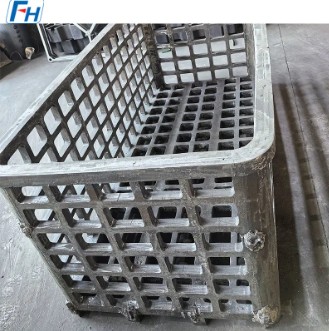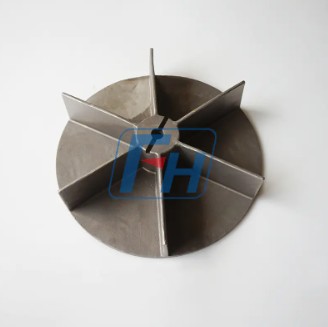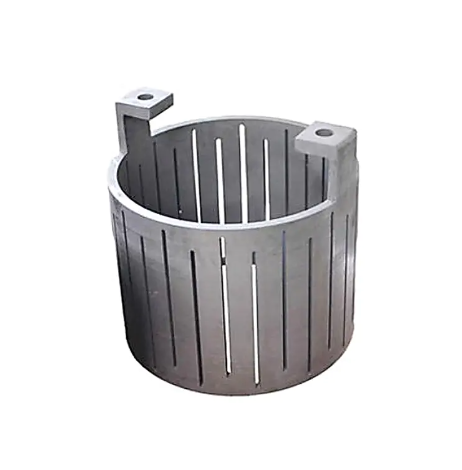
 0086-13338774804
0086-13338774804
Get in Touch





 Sep 29, 2025
Sep 29, 2025 Heat treatment baskets are carriers designed specifically for high-temperature heat treatment processes. They are typically made from heat-resistant alloys through lost-wax precision casting or centrifugal casting. They maintain dimensional stability and a smooth surface finish in furnace environments exceeding 800°C, effectively protecting workpieces from direct impact and oxidative corrosion during heating, quenching, and tempering.
1. Structural Features: An open mesh or grid-like interior ensures uniform heat transfer; the outer shell is constructed from a high-strength alloy, resisting thermal shock and deformation.
2. Manufacturing Process: Lost-wax precision casting achieves complex shapes and high-precision dimensions, making them compatible with a variety of furnace types (box, vacuum, piston, pit, bell, etc.).
3. Applications: Widely used in heat treatment equipment in the automotive, aviation, mold and die, and metallurgical industries. Compatible with mainstream furnace brands such as IPSEN, AICHELIN, ECM, KGO, NITRIX, AFC, IVA-SCHEMTZ, CODERE, and MATTASA.

What is the main function of a heat treatment basket?
1. Improved Loading Capacity and Production Efficiency
Through its proprietary structural design, the heat treatment basket allows for higher weight or volume loading within the same furnace chamber volume, achieving an optimal balance between weight-constrained and volume-constrained loading modes, significantly increasing single-batch production capacity.
2. Ensured Heat Treatment Uniformity
The high thermal conductivity alloy material and grid-like internal structure evenly distribute heat between workpieces, avoiding localized overheating or cold spots, and ensuring consistent heat treatment performance, including hardness and residual stress.
3. Extended Service Life and Reduced Operating Costs
The use of patented thermal resistance alloys (such as GH2132, Alloy 800, and Inconel 601) offers excellent resistance to oxidation, corrosion, and thermal fatigue. They maintain strength during rapid temperature cycles, significantly extending replacement cycles and reducing maintenance costs.
4. Improved Safety and Reliability
The robust structure and smooth surface prevent workpiece scratches or basket cracks, which could lead to in-furnace accidents. Furthermore, standardized dimensions and interfaces reduce assembly errors and enhance overall process reliability.

What materials are most commonly used to manufacture heat treatment baskets?
1. Ni-based superalloys (such as GH2132 and Alloy 800): Maintain high strength and an anti-oxidation film above 950°C, making them suitable for extreme heat treatment environments.
2. Inconel 601 (Ni-Cr-Fe alloy): Offers high-temperature strength, resistance to carburization, and sulfidation, and is commonly used in key components such as industrial furnaces, radiant tubes, and heat treatment baskets.
3. 22H high-nickel austenitic stainless steel: Contains 28% Cr and 50% Ni, providing excellent hot strength and carburization resistance, suitable for high-temperature furnace components operating between 950°C and 1250°C.
4. Traditional heat-resistant steels (40Cr, 42CrMo): Relatively low-cost, suitable for medium-temperature applications (≤800°C) where corrosion resistance is less critical. Wuxi Junteng Fanghu Alloy Casting Co., Ltd. has developed its own thermal resistance alloy formula and can provide customized materials based on the customer's heat treatment recipe (temperature, holding time, and atmosphere), achieving the optimal match between materials and processes.

How to inspect and maintain heat treatment baskets?

1. Visual and surface inspection
Regularly inspect the basket surface for cracks, deformation, oxide layer flaking, or abnormal welds, and promptly remove any residue and scale.
2. Nondestructive Testing (NDT)
X-ray/gamma-ray testing: This method uses penetrant radiation to detect internal defects (pores and cracks) and is the preferred method for inspecting the internal quality of castings.
Ultrasonic testing (UT): This method uses ultrasonic echoes to measure wall thickness and internal defects, making it suitable for thickness monitoring of thick-walled baskets.
Penetrant testing (PT)/magnetic particle testing (MT): This method allows for rapid location of surface or near-surface cracks.
3. Dimension and Flatness Measurement
Critical dimensions (aperture diameter, grid spacing, and overall flatness) are calibrated using a three-dimensional coordinate measuring machine or laser scanner to ensure uniform loading during loading.
4. Surface Treatment and Regeneration
After each heat treatment, high-temperature degreasing and decarbonization are performed. If necessary, surface passivation or spray coating is performed to prevent oxidation and accelerated corrosion.
5. Replacement Cycle Management
Combining usage records, test results, and material life curves (e.g., oxide film thickness variation at 950°C for GH2132), a scientific replacement plan is developed to avoid downtime losses caused by material failure.

 Tue 09, 2025
Tue 09, 2025 
 Mon 09, 2025
Mon 09, 2025 
 Mon 09, 2025
Mon 09, 2025